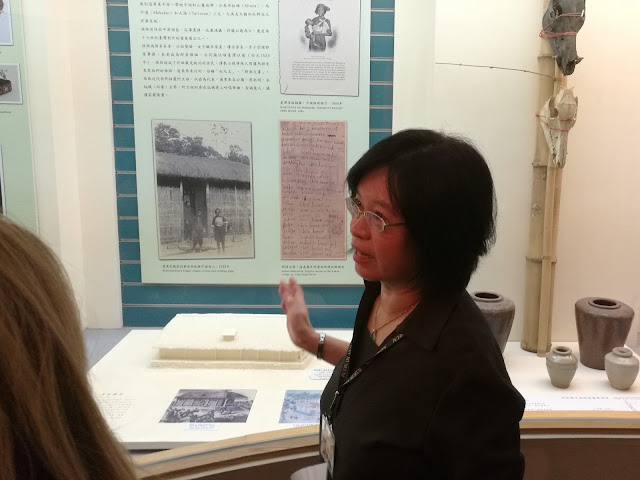The Taiwanese Indigenous People's Tour is a guided tour that takes place in a part of the National Taiwan Museum, a grand neo-classical structure built by the Japanese when they were the colonial power in 1908.
There were in fact three guides all offering the same tour to a large group of visiting foreigners. I tried to figure out which would be the most interesting guide by looking at them closely. I finally picked the lady on the left.
The tour was focussed on the pre-history and anthropology of Taiwan. There were the usual types of artifacts you would expect to find on such a tour augmented with photographs of excavations and maps. The exhibits themselves were relatively sleepy, the bread and butter stuff of a middle of the road museum.
Where the tour started to get interesting was in the fault lines: the guide was ethnically Han Chinese and spoke English and Mandarin. Language is a complicated, not to say divisive issue in this context as there are indigenous oral languages and then the mix of Mandarin and Taiwanese, also known as Minnanhua. The relative status of these languages, that is to say who knows them, when, how and why they are used, starts to open up a number of points within the exhibition and society more widely.
It became clear through questioning her that there has been a politicisation of Taiwanese pre-history from the 1990s onwards. This is an ongoing process of cultural de-sinification that has prompted a deeper examination of Taiwan's indigenous culture. What is meant by the term indigenous people is those who lived in Taiwan long before the arrival of the Han Chinese. This is significant as it becomes a way to mark a cultural difference between Taiwan and mainland China. This process has, to an extent, politically divided the country with a difference of emphasis between the two political parties, the more China friendly KMT and more pro-independence DPP.
Having seen, through the tour, how indigenous culture has been accorded a freshly important status, the next day I noticed stores selling what looked like Taiwanese ethnic craft objects. These designs have been re-purposed and shaped for modern living and now adorn notebooks, handbags, sports shoes and so on. Indigenous design therefore seems to play a role in identity politics and fashion in contemporary Taiwan.
There was one quite remarkable map which showed the full geographic reach of the indigenous culture that the exhibition depicted. The map shows connection with the indigenous cultures across the whole of Austronesian even going so far in the other direction as Madagascar. There is one place, however, that was strenuously avoided on the map: mainland China. The omission is significant and so too the blurring of the map at the top. There most probably is sound evidence to support this redrawing of the map but, ironically, the manner in which it is done also struck me as something that I am familiar with: to the outsider it all looks like a very Chinese form of presentation.







No comments:
Post a Comment